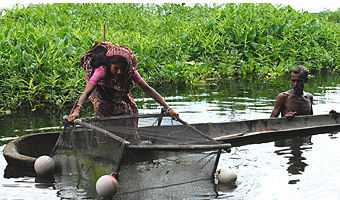 Chinese scientists have taken a lead role in spurring Uganda’s fish industry with the introduction of a new technology to boost commercial fish farming. The new model of cage fish farming focuses on commercialization of fish farming with a main focus on lakes, dams, reservoirs and rivers.
Chinese scientists have taken a lead role in spurring Uganda’s fish industry with the introduction of a new technology to boost commercial fish farming. The new model of cage fish farming focuses on commercialization of fish farming with a main focus on lakes, dams, reservoirs and rivers.
The project which started in April 2012 is being implemented by Chinese scientists through a three-year China-Uganda cooperation in aquaculture research. According to Barry Kamira a research scientist at the National Fisheries Resources and Research Institute (NaFIRRI) and the coordinator of the project, the metal cage fish technology is being introduced to foster the fisheries sector of the economy. “We have to adopt diversity and modern ways of fish farming to supplement the traditional means and eventually maintain the insatiable demand.”
Karima explained that many of the Ugandans’ livelihoods mainly depend on fish farming. “Fish farming supports 4.2 million smallholder farmers in Uganda and the country earns around US$116 million a year from fish exports. Fish is an important commodity that Uganda is exploring how to advance in its development agenda.”
This technology, unlike pond fish farming, relies on metal cages of various sizes that are suspended in a water body. Each cage carries up to 10,000 fingerlings. Fish farmers use a measure of their efficiency in converting food mass into increased body weight to know when to transfer the young fish to the next cage until they mature for harvesting six months later.
Currently the pilot project is being funded by the Chinese government to enable knowledge and technological transfer and adoption by the locals. When the trial ends, the Ugandan government is expected to roll out the technology nationally. Kamira noted that Uganda is taking the lead among the East African countries — Kenya and Tanzania to demonstrate the potential of rearing fish using metal cage fish farming technology to rapidly transform the sector from subsistence to commercial fish farming, according to Kamira.
Kamira explained that while Kenya is also in its early stages of applying the technology, water hyacinth which is an invasive plant species growing in Lake Victoria, which is shared by Kenya, Uganda and Tanzania is hampering the process.
The need for the technology has grown because of a drastic decline in fish production resulting in the country neither meeting national demands nor having enough fish for export. "Despite its long history dating back to the early 1950s, fish farming in Uganda has not developed beyond small subsistence scale,” noted Kamira. According to Kamira, initial findings from a study to ascertain the safety of the method cleared any doubts about the environmental impact of the model.
In addition, the findings also noted that the technology can be used in other water bodies within the country like rivers, water reservoirs and small lakes like Lake Edward. "The technology does not have any negative effect on the water quality. We carry out water quality monitoring in triplicate, that is, at the demonstration area, downstream and upstream.”
The Chinese experts are building the capacity of NaFIRRI experts on how to operate the technology and will transfer the necessary skills to Uganda to use it commercially. The government and other stakeholders involved in the project are hoping that deepening and adoption of the technology will foster fish farming in the country and eventually commercialize the practice. "Through this technology, people will have enough money for their livelihoods and generate more revenue for the government by using the full potential of the natural water bodies like lake Victoria to breed and rear fish," added Karima.
















Comments powered by CComment